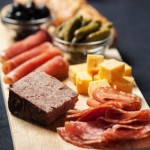These freezer essentials will help you with your weekly meal prep as well as last minute meals that you need to get on the table fast.
Bagged frozen vegetables, like mixed peppers, broccoli, and spinach.
Bagged frozen fruit, like blueberries, mangos, bananas, and strawberries.
Bagged frozen pastas, like tortellini and ravioli.
Frozen waffles and pancakes.
Frozen potatoes, like tots, fries, and breakfast potatoes.
Rice and prepared side dishes.
Pre-made dough, pie crusts, and breads.
Frozen foods are not limited to frozen dinners. You can stock your freezer with healthier ingredients to make putting dinner together easy. There are endless possibilities with what you can make with frozen ingredients. As always, be creative and “work with what you got!”
“Work With What You Got!”
©Tiny New York Kitchen © 2020 All Rights Reserved
Start small, with goals that work for you and your family. These are the habits you’ll keep in the long run.
1. Add More Color To Your Plate
More color on your plate means more variety, more nutrients, and more flavor. The next time you shop, try putting the rainbow in your cart: orange citrus, yellow pineapple, and dark leafy greens.
2. Eat Seasonally
Keep a produce calendar handy so you know what to look for. In season produce is fresher and typically less expensive. January is good for root vegetables, kale, and citrus.
3. Drink More Water
Stay hydrated by infusing your water with citrus slices, herbs, berries, or cucumber. Making water more interesting will encourage you to drink more.
4. Try A Whole Grain Swap For Pasta And Bread
Once in a while replace regular pasta and bread with a whole grain alternative. These complex carbs will help you feel full. Look for whole wheat, whole grain, and multigrain alternatives.
5. Pack Your Snacks
Opt for high fiber and protein snacks like hummus and pretzels or apples and peanut butter. Unlike sugar and empty carbs, fiber ad protein will keep you full.
6. Eat Breakfast More Often
Stock up on on-the-go options. Egg muffins in the freezer, instant oatmeal in the pantry, and a bowl of fruit on the counter. The morning rush won’t be an excuse for skipping this important meal.
7. Make A Shopping List
Check your refrigerator, freezer, and pantry before making a list. Organize your list based on the layout of your store. You’ll save time at the store and won’t accidently buy what you already have.
8. Try A Plant-Based Swap For Meat
Try a meatless version of a weeknight staple like burgers, pizza, or pasta. You’ll get more nutrients into your meals by swapping meat for plant-based options.
9. Stock Your Freezer
Keep staples like frozen meatballs or chicken tenders and steam-in-bag vegetables for last minute meals. A fully stocked freezer is better than takeout. You’ll save money and get dinner on the table even on busy weeknights.
10. Reduce Your Food Waste
Use overripe fruit in smoothies and muffins. Turn leftover vegetables into stir fries and soups. Turning leftover produce into nutrient-dense meals is a win-win for your wallet and your health.
11. Make A Meal Plan
Write meals on the calendar at the start of the week. Everyone knows the menu and you won’t be scrambling for dinner ideas at 5pm.
12. Bring Your Lunch 3 Days Per Week
Instead of swearing off midday takeout, start with 3 days a week. When you pack school lunches, pack office lunches too. You’ll save time waiting in line, save money, and eat better.
13. Try A New Recipe
Shake up your dinner routine with a recipe or ingredient you haven’t use before. You’ll avoid a recipe rut and learn new kitchen skills.
14. Eat Out One Less Time Each Week
Try a speedy dinner or slow cooker meal that’s ready when you get home. Home cooked meals allow you to control the ingredients and choose more healthful options.
15. Drink Less Soda
Swap for flavored seltzer, iced tea, or sparkling fruit juice. Instead of cutting out soda try drinking 1 less can a day. Quitting cold turkey makes habits hard to break. Start with a smaller goal and eventually it will make a big difference.
16. Eat Together One More Night Each Week
Make dinner device-free, with everyone eating together. Keep it fun with a top-your-own taco, baked potato, or burger night. Enjoying a meal together as a family has been shown to encourage healthy eating habits and better communication.
17. Cook With Your Children Once A Week
Children who help choose, shop for, and prepare a recipe will be more interested in eating it.
18. Get Ahead On Sunday
Prep components instead of entire meals. Roast vegetables, cook grains, and bake extra chicken, then mix and match for quick lunches and dinners during the week. Planning ahead helps you save time, eat better, and reduce the stress of busy weeks.
19. Embrace Healthy Fats
Look for sources of unsaturated fats, like olive oil, nuts, seeds, and avocados. Good-for-you fats help regulate cholesterol, absorb vitamins, and prevent heart disease.
20. Give Plants More Plate Real Estate
Fill about half of your dinner plate with plants, then divide the rest between your starch and protein. Rebalancing your plate is an easy way to eat healthfully.
“Work With What You Got!”
©Tiny New York Kitchen © 2019 All Rights Reserved
A Charcuterie Board makes entertaining super easy. Whether you call it a charcuterie plate or a charcuterie board, it’s easy to make when you begin with quality smoked, cured, and cooked meats. The perfect charcuterie board will contain at least 3 to 5 types of charcuterie representing different styles and textures, an assortment of cheese, plus something acidic, like pickles and olives, and something sweet like fruit chutney to complement the flavors. Nuts, fresh and dried fruits, bread, and crackers also make wonderful accompaniments.
Start with a wooden board, plate, platter, or piece of slate as the base.
Choose at least 3 to 5 charcuterie items that represent various styles and textures: smoked and meaty, dry-cured and firm, cooked and creamy. Allow two ounces per person, and slice your charcuterie into easily manageable, bite-sized pieces.
Spread the pieces out on the board, leaving space between them for accompaniments.
Add mustard, cornichons, olives, or chutney, so the acidity can balance the fat in the charcuterie.
Fresh fruits like grapes, figs, sliced pears, and apples, and any dried fruits like raisins, currants, apricots, cherries, and pears will round out the board, and add color. Use the fruits as palate cleansers between bites of charcuterie.
Place sliced bread, or various types of crackers, around the edges of the board, or tuck them between sections of charcuterie.
Cheese is a welcome addition to a charcuterie board. Choose 2 to 3 types of different textures to complement the spread.
Add truffle butter, which is especially tasty on a slice of bread with dry-cured meats like saucisson sec.
A hearty red wine makes a good accompaniment, such as Côtes-du-Rhône, Gigondas or Madiran.
Types Of Charcuterie To Consider:
Prosciutto: Probably the most recognizable pork offering on the list. Each region of Italy has its own signature recipe and flavor profile, but the most common are from Parma, Tuscany, and San Daniele. Culatello is a boneless cousin of prosciutto with a higher meat-to-fat ration. If you’d like to avoid the fat, Spanish lomo and Italian lonzaare alternatives made with pork loin.
Soppressata: We like to think of soppressata as the adult pepperoni. This salumi is generally made from dry-cured, coarse ground pork with red pepper flakes from Southern Italy, though regional variations do exist.
Finocchiona: Packed with fennel seeds, this skinny Italian salami was first created during the Renaissance. If you’re not a fan of anise, try French saucisson sec, made with garlic and pepper.
Chicken Liver Mousse: This creamy, butter spread is a nice introduction pâté for those who are new to offal.
Pork Rillette: If you love pulled pork then this is for you. This rillette is slow cooked with spices, cut up, often pounded into a paste and topped off with rendered fat.
Speck: This lightly smoked prosciutto comes from Northern Italy. Also, worth getting is guanciale, cut from the jowl, or a spice-cured fatback called lardo.
Chorizo Picante: A Spanish pork salami, chorizo picante is spiced with hot paprika, not to be confused with the fresh chorizo sausages of Latin America.
Coppa: Short for capocollo, coppa is an Italian and Corsican dry-cured pork neck and shoulder salume (capo is Italian for head, while collo means neck). A spicy version is also available.
Duck Rillette: In this rillette, duck leg confit is shredded before being mixed with spices and Armagnac. It’s then crowned with duck fat, which is more delectable and slightly lower in saturated fats than pork.
Mousse du Périgord: A signature creation of Les Trois Petits Cochons, a famed charcuterie formed in New York City’s Greenwich Village, this blend of chicken and turkey livers is infused with herbs and bits of black truffle. Expect a bite that’s silky and smooth, with a top layer of aspic, a meat jelly.
Jamón Ibérico de Bellota: This is where jamon reaches its peak. It’s a Spanish ham where the pigs are allowed to graze acorns and herbs freely, which gives the meat a very unique aroma. A more affordable version is jamón serrano. For a woodsy addition, Bauernschinken is a similar option that’s smoked with juniper.
Bresaola: An air-dried beef round from Northern Italy’s Lombardy region.
Black Truffle Salami: Creminelli offers a tartufo salami that’s delicious. It’s embedded with summer truffles whose flavors and aroma integrate beautifully with the pork.
Rabbit Rillette: Versions of this rillette can be perfumed with juniper, mace and/or thyme. Rabbits aren’t as fatty as other animals, so these are often topped with duck fat.
Pâté de Campagne: Country pâté can be tough for some people because of its visible parts of offal and fat. Trust in a high-quality pâté that showcases beautiful chunks of ham. For an impressive upgrade, try pâté en croûte, a rustic loaf of pâté wrapped in pastry.
Tips For Serving:
Charcuterie can be enjoyed as an appetizer or a meal. If you want prosciutto for breakfast, go for it. For entertaining, charcuterie is a popular option because it can be put together ahead of time and covered with plastic wrap.
Remove all inedible material like twine, cloth, and tough salami casing before slicing.
Cubes are fine for cheese and cold cuts, but chunky charcuterie might be hard to bite or deliver too much salt per portion. Salted cured meats are best sliced thin and served immediately.
When you place charcuterie, drape each slice like you just shaved it yourself. Not only does it look attractive, it keeps each piece separated so that guests won’t struggle to peel them apart.
Choose a flat board or platter so everything can get picked up with tongs or a fork. It’s especially important if anything needs to be sliced, like a loaf of pâté.
Lipped, round serving trays are great if there are jars, small bowls, or ramekins that may be prone to slipping. To prevent small containers from sliding, wet a small cocktail napkin and fold it so it is hidden beneath the container.
Eat sliced meats with your hands, forks, or toothpicks. Don’t forget a knife for the pâté and rillettes.
Have fun with thin sliced meats by wrapping them around melon, asparagus, batons of cheese or grissini.
Since charcuterie tends to be in the red-brown range of the color spectrum, lay down a bed of sturdy greens like arugula as a base. In addition to being visually impressive, it makes cleaning much easier.
Invite cultured butter and cheese to the party. Let butter soften to room temperature so it’s easy to spread. Cheese from the same regions as your meats will complement each other nicely.
“Work With What You Got!”
©Tiny New York Kitchen © 2019 All Rights Reserved
The fruit that is available in the autumn isn’t nearly as abundant as the fruit that’s available in the summer, but there are actually some delicious seasonal autumn fruits that you can look forward to eating. Delicious, tasty, and healthy seasonal autumn fruit is also a refreshing alternative to the heavier food we tend to eat in the colder months. If you love fruit and have been missing summer’s bounty, there are plenty of autumn fruits that will satisfy your craving.
Apples are one of the quintessential autumn fruits. Every fall you will see crates full of apples at farmers’ markets. Try venturing out and get some of the lesser known varieties of apples. Each variety tastes very different and autumn is the perfect time to try all of the different varieties.
Pears are best in autumn even though you can get them year-round. In fall they make a great snack. Like apples, there are many different varieties of pears. Try as many different varieties as you can.
Pomegranates are so delicious because they’re the right combination of tart and sweet. The best pomegranates start being available in late October and early November, which means you must wait for most of autumn for them to be available.
Cranberries are not a fruit that most people think of eating. In fact, cranberries usually only make an appearance as cranberry sauce or jelly. However, there are actually other uses for this tart fruit. They make excellent smoothies when blended with oranges and bananas. Cranberries also taste great when roasted along with vegetables because they add a nice tart bite.
Grapes are a fruit that people eat by the handful. They’re delicious, and they make a nice healthy snack that children and adults love. If you have a chance, try some concord grapes this fall. They are a nice treat and a change from the globe grapes that we always find in the market.
Figs start making an appearance in grocery stores in early fall. They can be expensive, but they’re worth it. They have a wonderful sweet flavor that’s not too intense. Figs do have delicate skin so if you do buy them, make sure you plan on eating them right away.
Persimmons are a sweet fruit, but when you get persimmons you should make sure they’re fully ripe before eating them. Unripe persimmons are very astringent. Make sure they are plump and juicy before taking a bite.
“Work With What You Got!”
©Tiny New York Kitchen © 2019 All Rights Reserved
Healthy snacks give your family the energy and nutrients they need throughout the day. As you plan snacks, think of them as “mini meals” that include two of the four food groups.
Try these simple nutritious snack ideas:
1. Whole grain crackers with a cheese stick
2. Fresh cut fruit with a yogurt dip
3. Nut-free trail mix. Mix dried cranberries, raisins, dried apricots, and apple rings with sunflower and pumpkin seeds, along with your family’s favorite cold cereal.
4. A small tortilla wrap spread with Greek yogurt, some jam and a banana.
5. A smoothie made with vanilla yogurt, blueberries, apples and some orange juice.
6. Vegetable sticks (like cucumbers and carrots) dipped in hummus.
Make snacks interesting by using a variety of shapes, colors, and textures.
• Offer different types of cheese (mozzarella, cheddar, Jack, Swiss) in different forms (cubes, strings, slices, and balls)
• Switch up the vegetables and fruit. Make sure you have a colorful variety in the fridge to choose from.
• Kids love to dip. Use cottage cheese, hummus, yogurt, or guacamole as healthy dips.
From planning to packing, get everyone in the family involved when making snacks. Take children grocery shopping and let them choose some of their favorite foods like breads, vegetables, fruit, and yogurts. Set aside time in the evening to pack lunches and snacks. You’ll be happy you did during the next day’s busy morning rush!
Food Allergies: Schools have different policies when it comes to food allergies. Many schools have a nut-free policy throughout the whole school, and some have policies just for some classrooms. Find out about the food allergy policy at your child’s school. Once you know about the foods that need to be avoided, keep them in mind when reading the ingredient list on food labels and when packing lunches.
Back to school snacks can be nutritious and delicious. With a little planning and creativity, your kids will love snack time at school.
“Work With What You Got!”
©Tiny New York Kitchen © 2019 All Rights Reserved
Stone fruit is at its peak during the summer.
Look for fruit without any bruises, cuts, or soft spots.
Peaches bruise easily – hold in the palm of your hand to check ripeness instead of squeezing.
Give a sniff. Ripe fruit has a fragrant scent that makes you want to take a bit.
Ripen peaches by storing in a paper bag for 2 to 3 days at room temperature out of direct sunlight.
Keep cherries in the refrigerator.
All stone fruits offer good-for-you fiber and antioxidants.
Stone fruits are low in calories.
Peaches are a great source of vitamins A and C.
“Work With What You Got!”
©Tiny New York Kitchen © 2019 All Rights Reserved
Juicy berries are bursting with flavor and now is the perfect time to pick them up, whether for snacking or adding to sweet and savory recipes.
Make sure to look for bright, shiny strawberries, and skip any that are smashed, shriveled, or moldy. Their color should be deep and even, with no white or green patches, and they should smell fragrant.
Wait to wash them. Water increases the risk of mold, so leave berries in their original packaging and rinse in cold running water just before serving. Their shelf life is short, so serve or cook berries within 2 to 3 days.
Despite their sweetness, strawberries are relatively low in sugar. They also provide fiber, antioxidants, and vitamin C. In fact, strawberries contain more vitamin C per serving than oranges!
“Work With What You Got!”
©Tiny New York Kitchen © 2019 All Rights Reserved
Most vegan foods are quite obvious, but it’s important to check the label for ingredients like egg whites, gelatin, honey, or milk.
When in doubt at a restaurant, ask your server to confirm your order is vegan. Dishes are often enriched with non-vegan ingredients like chicken stock or fish sauce.
Rather than focus on what you can’t eat, celebrate what you can. Vegans can enjoy a wide range of foods, including all fruits and vegetables, beans and other legumes, pasta and grains, soy-based foods like tofu and tempeh, and herbs and spices.
“Work With What You Got!”
©Tiny New York Kitchen © 2019 All Rights Reserved
Nothing compares to crisp and juicy in-season apples, and now is the perfect time to make the most of them in both sweet and savory dishes.
Pick Like A Pro
When shopping, avoid apples with nicks, bruises, or soft spots and seek out fruit that’s firm and heavy for its size. Make sure the skin is smooth and shiny, as dull skin is often a sign that apples are lacking in taste and texture.
Keep Cold
Apples lose their crispness at room temperature, so be sure to store them in the refrigerator, where they’ll keep for up to three weeks. Separate soft or bruised apples, which can cause perfectly good ones to soften more quickly.
Know The Benefits
Apples are more than just a low-calorie snack. They’re also packed with fiber, which has been shown to reduce the risk of some cancers, as well as heart disease. Plus, fiber keeps tummies feeling full, so you’re less apt to reach for sugary treats.
Apples Love Lemons
A squeeze of lemon juice helps keep cut-up apples from browning.
www.tinynewyorkkitchen.com
“Work With What You Got!”
©Tiny New York Kitchen © 2018 All Rights Reserved
Drizzling olive oil over savory fruits like tomatoes is second nature, but put it on sweet fruit and people start to think you’re crazy. Consider this: Olive and watermelons are both fruits, and just as vegetable-driven salads need fat to balance salt and acid, fruit salads crave the mouth-coating richness of oil to complement their sweetness and acidity. Olive oil is ideal since it brings a sharp aromatic flavor of its own that carries other savory ingredients, like nutty sharp cheeses and spicy sauce. Look for lighter, grassy oils to avoid overwhelming your fruits, but even a bold, peppery one can play nice with whatever you care to throw at it.
“Work With What You Got!”
©Tiny New York Kitchen © 2018 All Rights Reserved















